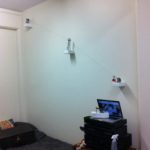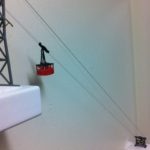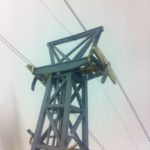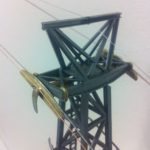…Cableways
Cableways take many forms, with the two main types being rope bound or rail bound. Rope bound cableways include chair-, gondola- and cabin lifts where the ‘vehicles’ are either attached directly to an endless cable, or they can have trolleys or bogies with many wheels that run on a fixed rope and are hauled by a separate cable. The latter type generally has two cabins that shuttle up and down in opposite directions.
The function of a two-cabin cable way demonstrated with the BRAWA model
of the ‘Nebelhornbahn’, scale 1:87.
A continuous loop layout has chairs or gondolas attached to a moving rope. The fixings may be permanent, or they can be disconnected at the top and bottom termini to allow passengers to get on and off safely. Additional seats for use during peak times may be stored in sidings.
BRAWA’s ‘Kanzelwandbahn’ features tiny four-seater cabins on an endless cable.
As is usual with things in my collections, these cableways came to me in a terrible state. Initial testing was done by setting up the equipment on a bookshelf and since I do not have a suitable model railway layout, I decided to mount them on a wall instead.
The plinths that the infrastructure rests on are made of MDF, with a wooden ‘plug’ screwed securely to the wall. The electrics, encompassing a multi-tap transformer supplying the voltage required for both, are concealed within.
Funiculars are similar to railways, except they are propelled by stationary machinery connected to the cars by a cable looped around very large pulleys at the upper terminus. A short section of double track at the half-way point allows the two cars to pass each other. Double flanged wheels on one side follow the path set by the outer rails, while a cylindrical roller runs on the inner rails. This ensures the cars always divert the same way and the cable cannot get crossed.
Somebody else’s BRAWA funicular in operation.





















